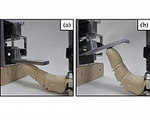Shape Memory Alloy Leads to Better Prosthetics
 Oct-11-15
Using a 3D printer and a shape memory alloy, researchers have developed a natural-feeling robotic finger that could open the door to more realistic prosthetic hands.
Oct-11-15
Using a 3D printer and a shape memory alloy, researchers have developed a natural-feeling robotic finger that could open the door to more realistic prosthetic hands.Created by a team a Florida Atlantic University, the finger was made using a shape memory alloy surrounded by a soft, 3D-printed shell based on a scan of a real finger. The shape memory alloy will bend when triggered by heat, mimicking the motions of an actual finger.
Because the motion of the finger relies on a shape memory alloy instead of the typical rigid components such gears, the 3D-printed finger is better able to retain a soft, human-like feel.

More Info about this Invention:
[MEDGADGET.COM][SCIENCEDAILY.COM]

Add Your Comment